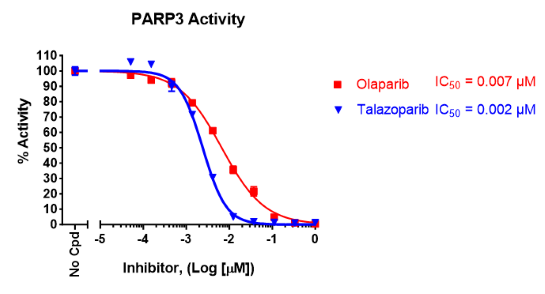PARP3 Homogenous Assay Kit
The PARP3 Homogeneous Assay Kit is designed to measure PARP3 (poly-(ADP-ribose) polymerase 3) activity for screening and profiling applications. The PARP3 Homogeneous Assay Kit comes in a convenient 384-well AlphaLISA® format, with enough purified recombinant PARP3, biotinylated histone substrate, ADP-Ribose Binding Reagent 1 and assay buffer for 400 enzyme reactions.

Figure 1: PARP3 Homogenous Assay Kit schematic.
A sample containing PARP3 is incubated with a biotinylated histone substrate and NAD+ for one hour. This is followed by the addition of acceptor beads and ADP-Ribose Binding Reagent 1, and finally donor beads. Alpha-counts are then measured. Alpha-counts are directly proportional to PARP3 activity.
Need us to run inhibitor screens or profile your compounds against PARP3? Check out our PARP/PARPTrap™ Screening Services or DNA Replication and Repair Screening Services.
- AlphaLISA® Anti-Rabbit IgG Acceptor Beads (Perkin Elmer #AL104C)
- AlphaScreen® Streptavidin-Conjugated Donor Beads (Perkin Elmer #6760002S)
- Optiplate - 384 (Perkin Elmer #6007290)
- AlphaScreen microplate reader
| Catalog # | Name | Amount | Storage |
| 80503 | PARP3, GST-Tag* | 5.2 µg | -80°C |
| 5X PP-01 Assay Buffer | 2 x 1 ml | -80°C | |
| Biotinylated Histone Substrate | 500 reactions | -80°C | |
| 78311 | ADP-Ribose Binding Reagent 1 | 10 µl | -80°C |
| 750 µM NAD+ | 400 µl | -80°C | |
| 0.5 mM DTT | 200 µl | -20°C | |
| 4X Detection Buffer 1NP | 2 ml | -20°C |
*The initial concentration of enzyme is lot-specific and will be indicated on the tube containing the protein
PARP3, also known as poly-(ADP-ribose) polymerase 3 or NAD+ ADP-ribosyltransferase 3, is part of the PARP family. ADP ribosylation, which is the addition of an ADP-ribose to a protein, is a reversible post-translational modification of proteins mostly involved in the DNA Damage Response (DDR) pathway. Mono-ADP-ribosylation (termed MARylation) is the addition of a unit of ADP-ribose. PARP3 is involved in programmed and stress-induced double strand break repair via classical NHEJ (non-homologous end-joining). In the absence of PARP3, DNA repair is less efficient, and cytotoxicity is potentiated when DNA damaging insults occur. It has been linked to cancer, with upregulation of PARP3 occurring in TGFβ (transforming growth factor β)-induced cell EMT (epithelial to mesenchymal transition) in breast cancer. It also promotes cell stemness. The use of inhibitors towards PARP3 can refrain cells from EMT. In addition, the mTORC2 (mTOR complex 2) signaling pathway is impacted, contributing to synthetic lethality in cells deficient in a complementary DNA repair pathway, such as in BRCA1 (breast cancer type 1 susceptibility protein)- triple negative breast cancers (TNBC). PARP3 acts in synergy with PARP1 in the response to ionizing radiation, and the use of inhibitors for both PARP1 and PARP3 also provides an opportunity to reduce the concentration of both and decrease the radiation regimen.
Rodriguez-Vargas J., et al., 2019 Cell Cyle 18(12): 1295-1301


